ResNet
论文地址:http://arxiv.org/abs/1512.03385
Question?
一个网络性能的提升是否能够可以通过简单的堆叠网络的层数?
随着网络的加深,出现了训练集准确率下降的现象,我们可以确定这不是由于Overfit过拟合造成的(过拟合的情况训练集应该准确率很高);所以作者针对这个问题提出了一种全新的网络,叫深度残差网络,它允许网络尽可能的加深。
Answer!
网络训练的过程中可能存在梯度消失/爆炸,现在通过规范初始化和中间层归一化技术,在配合以BP为基础的SGD基本上可以训练浅层网络。
但是当网络深度增加时,就会暴露出另一个问题: 随着网络的深度增加,网络的错误率却在上升。
有什么用?
用于深层网络的训练,可防止梯度小时和梯度爆炸,在深度增加的同时降低错误率。
如何用?
这个问题,正在进展中,ResNet在深层网络的训练中能够有效加快并降低错误率。但是如何应用到我们的项目中?
两种方法,其一是调用开源框架中API接口,其二是实现源码,形成接口去调用,这两个都处于进展中。后序更新。
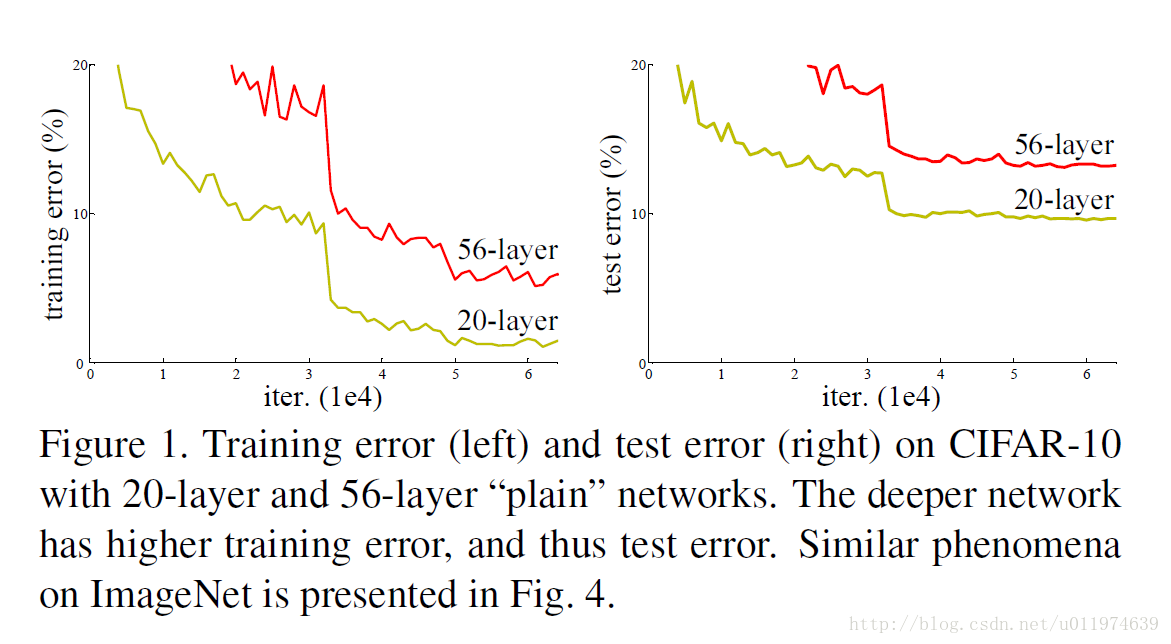
degradation问题说明了不是所有的系统都是容易优化的,我们可以这么想,针对一个浅层的网络,如果这个网络达到了一定得性能后,我们在该网络的基础上叠加新的网络层(简称深层网络),那么深层网络应该比浅层网络的性能不差,因为如果浅层网络已经是性能最好的话,那么多叠加的网络层学习到后面都为恒等映射(identity mapping)即可,但是实际情况却是训练的误差也在上升,那么就是网络本身有问题了。
解决办法
针对网络本身的问题,文章提出了一个新的网络结构–deep residual learning framework(深度残差学习框架),下面就来详细讲解一下这个新的结构相比以前的网络有啥提升的.
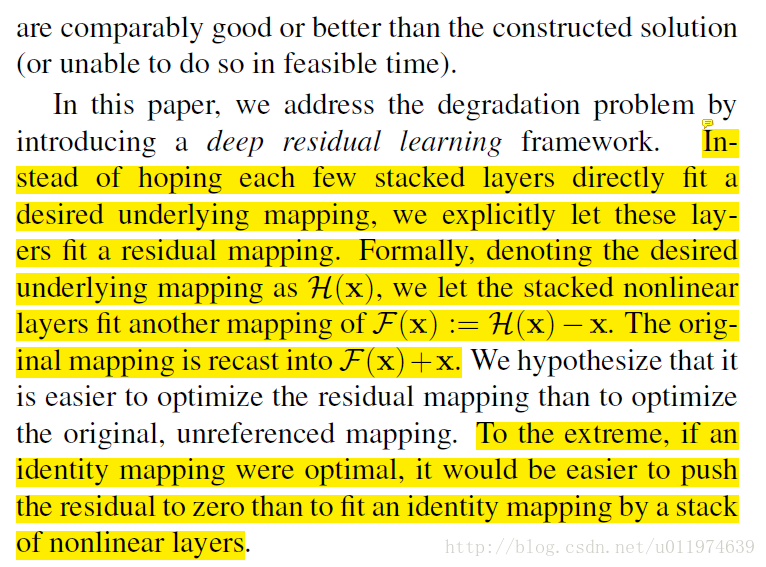
我们将原先堆叠的网络层从一个直接的映射(desired underlying mapping)用一个新的映射代替了,这个新的映射 们称之为residual mapping,即如果我们假设我们期望的映射为H(x),设原本网络的非线性映射为F(x)=H(x)-x, 那么期望的映射就可以写成H(x) = F(x) + x,现在F(x) + x的结构就是本文的resudial mapping,resudial mapping与原本的F(x)的区别很明显,就在于多了一个x。
我们可以考虑极端情况,如果我们需要学习一个恒等映射(即H(x)= x),我们认为通过堆叠网络使得原本的非线性映射F(x)优化为0的难度要比F(x)优化到1要简单.
为了证明这个新的映射好使,文章剩下的部分就是做相关证明工作了。
要证明新的映射好,那么先要设计并实现新的网络架构。
实现residual mapping
将residual mapping的每层用下图表示:
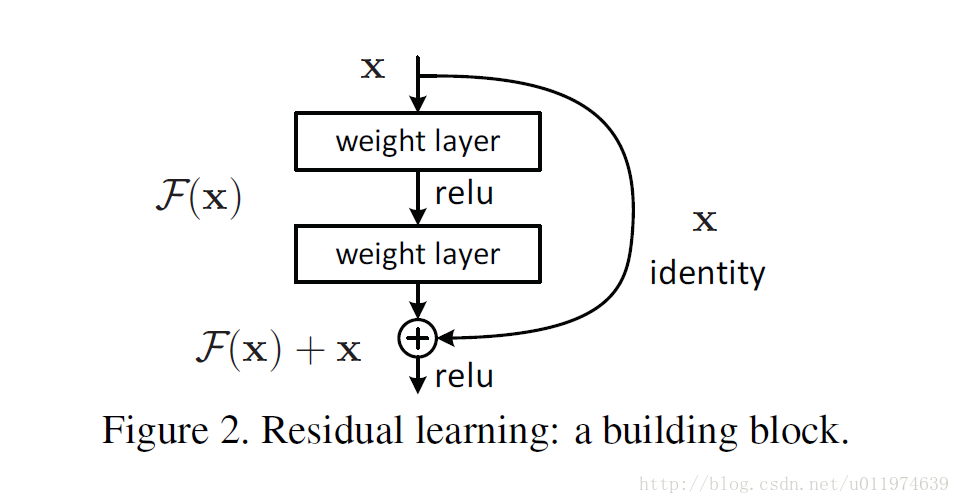
我们现在要优化的是一个残差结构,设定网络块为:
y = F(x,W) + x
# x and y are the input and output vectors
@add_arg_scope
def bottleneck(inputs,
depth,
depth_bottleneck,
stride,
rate=1,
outputs_collections=None,
scope=None):
"""Bottleneck residual unit variant with BN before convolutions.
This is the full preactivation residual unit variant proposed in [2]. See
Fig. 1(b) of [2] for its definition. Note that we use here the bottleneck
variant which has an extra bottleneck layer.
When putting together two consecutive ResNet blocks that use this unit, one
should use stride = 2 in the last unit of the first block.
Args:
inputs: A tensor of size [batch, height, width, channels].
depth: The depth of the ResNet unit output.
depth_bottleneck: The depth of the bottleneck layers.
stride: The ResNet unit's stride. Determines the amount of downsampling of
the units output compared to its input.
rate: An integer, rate for atrous convolution.
outputs_collections: Collection to add the ResNet unit output.
scope: Optional variable_scope.
Returns:
The ResNet unit's output.
"""
with variable_scope.variable_scope(scope, 'bottleneck_v2', [inputs]) as sc:
depth_in = utils.last_dimension(inputs.get_shape(), min_rank=4)
preact = layers.batch_norm(
inputs, activation_fn=nn_ops.relu, scope='preact')
if depth == depth_in:
shortcut = resnet_utils.subsample(inputs, stride, 'shortcut')
else:
shortcut = layers_lib.conv2d(
preact,
depth, [1, 1],
stride=stride,
normalizer_fn=None,
activation_fn=None,
scope='shortcut')
residual = layers_lib.conv2d(
preact, depth_bottleneck, [1, 1], stride=1, scope='conv1')
residual = resnet_utils.conv2d_same(
residual, depth_bottleneck, 3, stride, rate=rate, scope='conv2')
residual = layers_lib.conv2d(
residual,
depth, [1, 1],
stride=1,
normalizer_fn=None,
activation_fn=None,
scope='conv3')
output = shortcut + residual
return utils.collect_named_outputs(outputs_collections, sc.name, output)
这种结构的实现是在原来网络的基础上添加一个通道(控制里面的前馈),这里新添加的通道需要跳过一个或者多个网络层,可以看到新的网络块不需要添加新的参数,而且新的网络结构依据可以通过SGD来训练,且这种新的网络实现起来也很方便,我们可以等同的比较原本的网络和新的网络结合的性能。
实验
下面我们测试了三个网络:
左边:VGG-19 Model(19.6billion FLOPs);
中间:普通的网络:使用多个3*3的小卷积核(以VGG网络的思想设计),遵循着两个设计原则:
- 对于相同的输出特征图尺寸,层与滤波器的个数是相同的
- 如果输出特征图的尺寸减半,那么滤波器的个数加倍,保持时间复杂度
网络共34层,以全局平均池化层和1000个分类的softmax层结束。
普通的网络需要(3.6billion FLOPs)右边:residual model:这是建立在普通网络的基础上的,可以看到网络的旁边多了很多前馈线,我们把这些前馈线也称之为shortcut或skip connections. 这些前馈线代表的是恒等映射。
前馈线应用会遇到两种情况:- 输入和输出的维度一致,那可以直接连接
- 如果输出的维度增加了,有两种办法
- 恒等前馈线不足的维度添加padding,padding的值为0
- 借鉴Inception Net的思想,经过1*1卷积变换维度
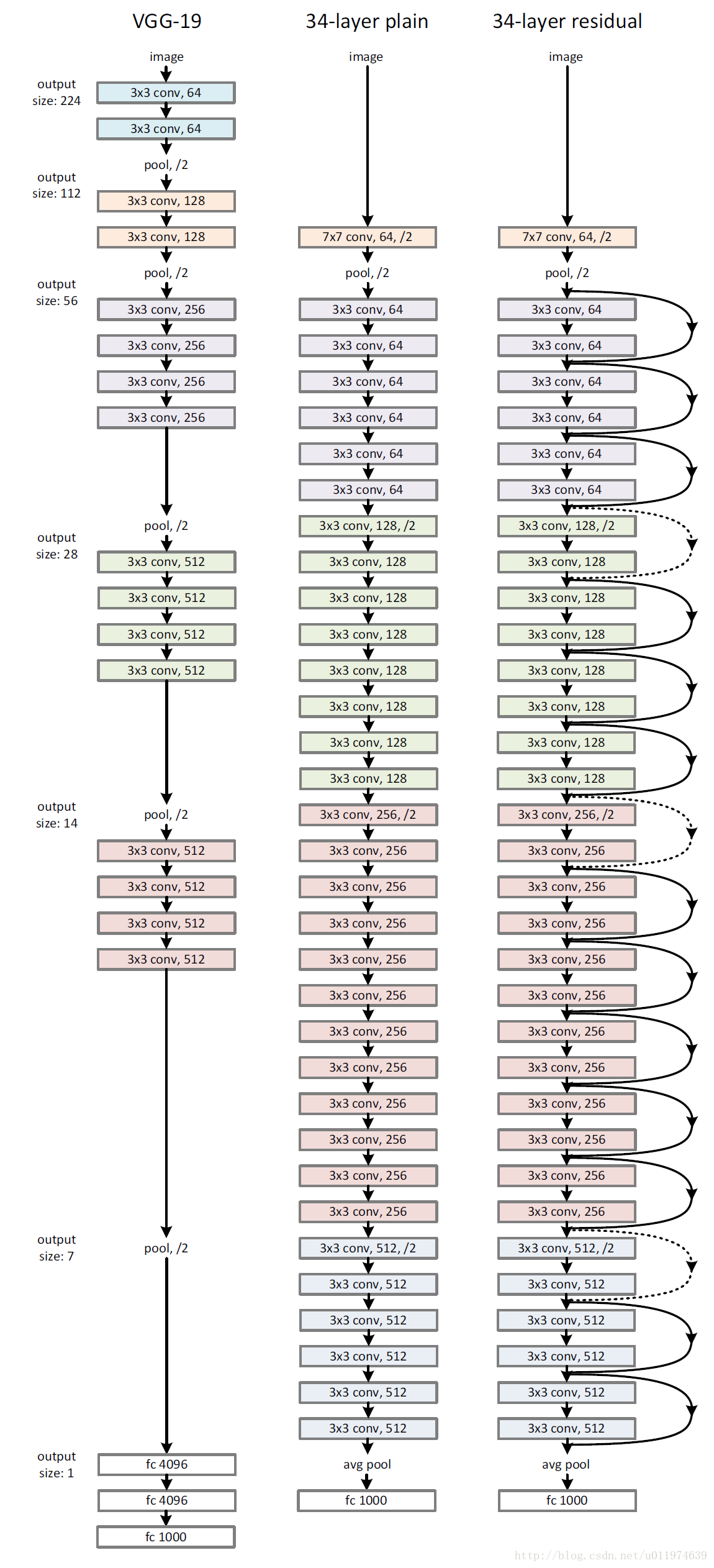
同时配置了不同层数的ResNet,如图:
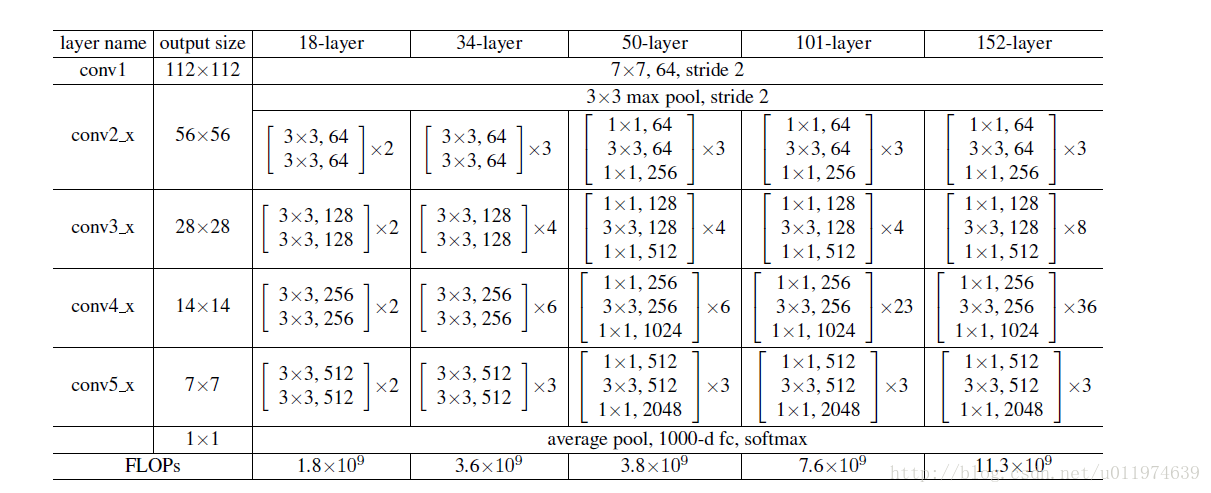
对于两层到三层的ResNet残差学习模块,设计如下: 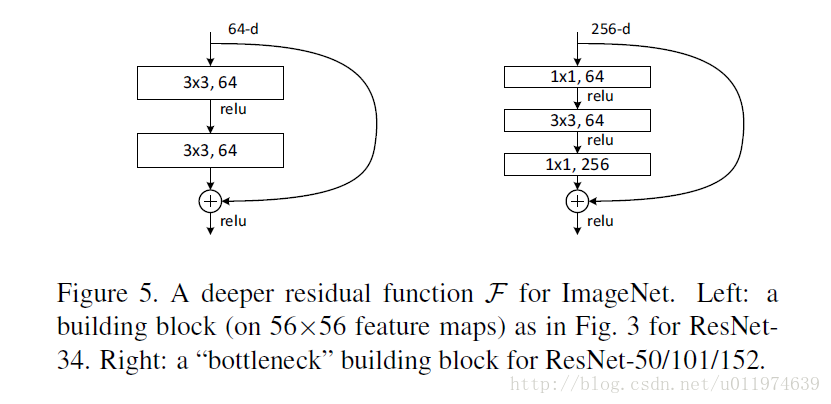
设计好网络,下面该做实验,分析结果了
实验结果
下图是ResNets与普通网络的对比,注意ResNets相对于普通网络是没有额外的参数的:
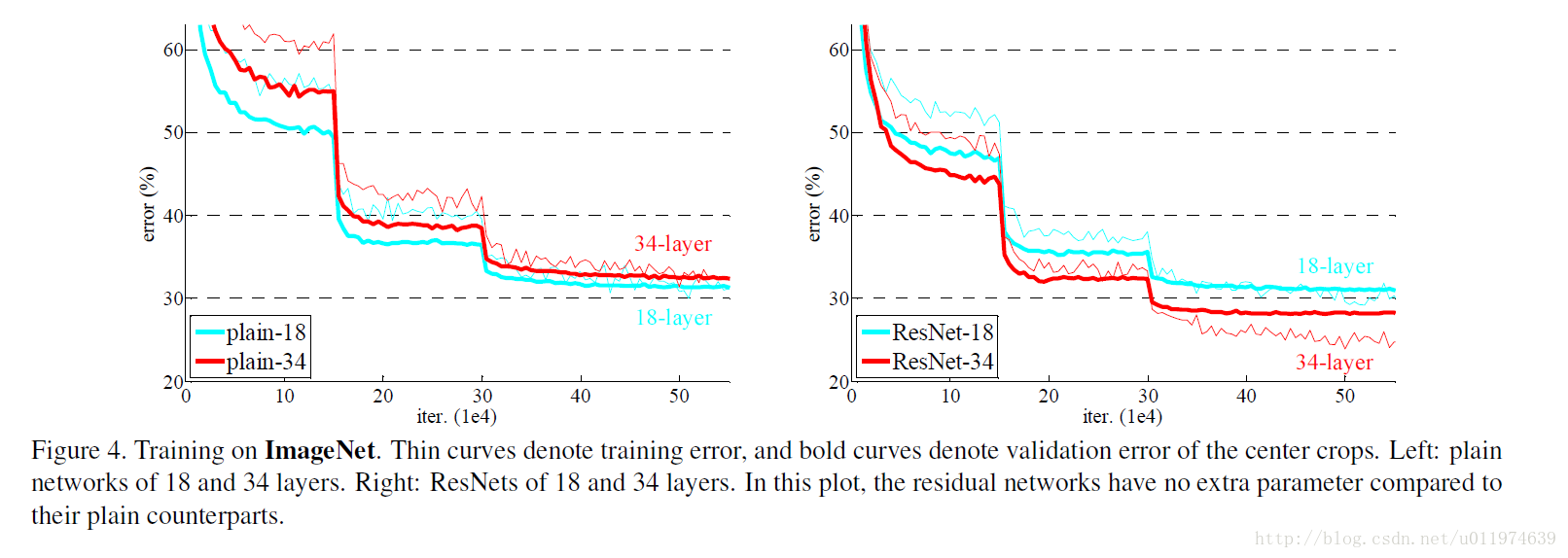
左边是普通网络随着迭代次数的增加,plain-18和plain-34随着迭代次数的增加,训练误差和验证误差的变化,加粗的是验证误差,细线为训练误差,可以看到无论是训练误差还是验证误差,随着迭代次数的增加,plain-34都比plain-18要大,这就是我们一开始说的degradation问题。
右边是residual net(使用的是零填充),可以看到随着迭代次数的增加 训练集和验证集的误差都继续下降了,说明residual net结构产生的效果确实比较好。
评估residual net在ImageNet数据集上的表现:
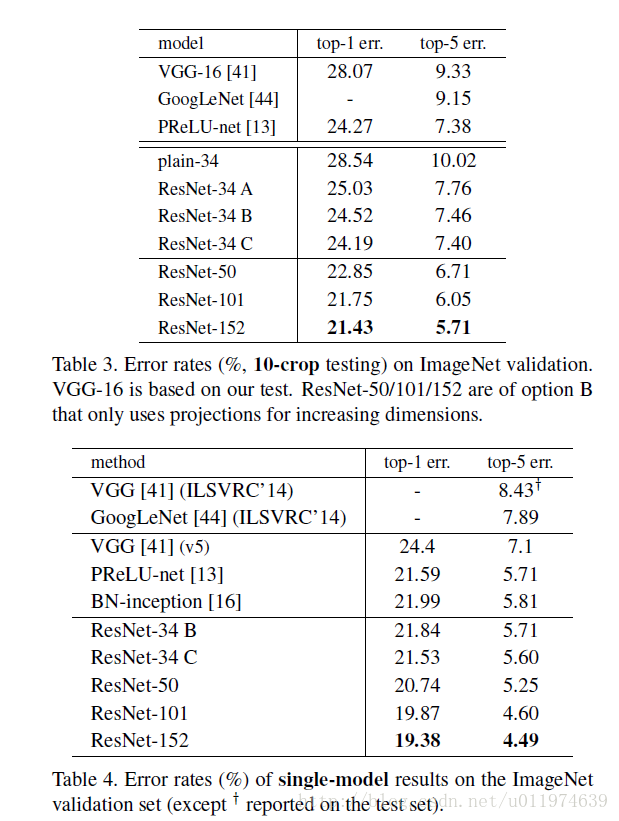
resNet-A是使用zero-padding,resNet-B是在等维使用恒等映射,否则使用shortcuts projection,resNet-C的所有shortcuts都是projection
可以看到residual net随着层数的增加,性能继续提升。
到这里论文分析就算结束了,下面分析ResNet在TensorFlow上的开源实现。
ResNet在TensorFlow上的实现
代码如下:
# coding:utf8
# %%
# Copyright 2016 The TensorFlow Authors. All Rights Reserved.
#
# Licensed under the Apache License, Version 2.0 (the "License");
# you may not use this file except in compliance with the License.
# You may obtain a copy of the License at
#
# http://www.apache.org/licenses/LICENSE-2.0
#
# Unless required by applicable law or agreed to in writing, software
# distributed under the License is distributed on an "AS IS" BASIS,
# WITHOUT WARRANTIES OR CONDITIONS OF ANY KIND, either express or implied.
# See the License for the specific language governing permissions and
# limitations under the License.
# ==============================================================================
"""
Typical use:
from tensorflow.contrib.slim.nets import resnet_v2
ResNet-101 for image classification into 1000 classes:
# inputs has shape [batch, 224, 224, 3]
with slim.arg_scope(resnet_v2.resnet_arg_scope(is_training)):
net, end_points = resnet_v2.resnet_v2_101(inputs, 1000)
ResNet-101 for semantic segmentation into 21 classes:
# inputs has shape [batch, 513, 513, 3]
with slim.arg_scope(resnet_v2.resnet_arg_scope(is_training)):
net, end_points = resnet_v2.resnet_v2_101(inputs,
21,
global_pool=False,
output_stride=16)
"""
import collections
import tensorflow as tf
slim = tf.contrib.slim
class Block(collections.namedtuple('Block', ['scope', 'unit_fn', 'args'])):
'''
使用collections.namedtuple设计ResNet基本的Block模块组的named tuple
只包含数据结构,包含具体方法
需要传入三个参数[scope,unit_fn,args]
以Block('block1',bottleneck,[(256,64,1)]x2 + [(256,64,2)])为例
scope = 'block1' 这个Block的名称就是block1
unit_fn = bottleneck, 就是ResNet的残差学习单元
args = [(256,64,1)]x2 + [(256,64,2)]
args是一个列表,每个元素都对应一个bottleneck残差学习单元
前面两个元素都是(256,64,1),后一个元素是(256,64,2)
每个元素都是一个三元的tuple,代表(depth,depth_bottleneck,stride)
例如(256,64,2)代表构建的bottleneck残差学习单元(每个残差学习单元里面有三个卷积层)中,
第三层输出通道数depth为256,前两层输出通道数depth_bottleneck为64,且中间层的步长stride为2.
这个残差学习单元的结构为[(1x1/s1,64),(3x3/s2,64),(1x1/s1,256)]
整个block1中有三个bottleneck残差学习单元,结构为
[(1x1/s1,64),(3x3/s2,64),(1x1/s1,256)]
[(1x1/s1,64),(3x3/s2,64),(1x1/s1,256)]
[(1x1/s1,64),(3x3/s2,64),(1x1/s1,256)]
'''
"""
A named tuple describing a ResNet block.
Its parts are:
scope: The scope of the `Block`.
unit_fn: The ResNet unit function which takes as input a `Tensor` and
returns another `Tensor` with the output of the ResNet unit.
args: A list of length equal to the number of units in the `Block`. The list
contains one (depth, depth_bottleneck, stride) tuple for each unit in the
block to serve as argument to unit_fn.
"""
def subsample(inputs, factor, scope=None):
'''
降采样方法,如果factor=1,则不做修改返回inputs,不为1,则使用slim.max_pool2d最大池化实现,
:param inputs:
:param factor: 采样因子
:param scope:
:return:
'''
"""Subsamples the input along the spatial dimensions.
Args:
inputs: A `Tensor` of size [batch, height_in, width_in, channels].
factor: The subsampling factor.
scope: Optional variable_scope.
Returns:
output: A `Tensor` of size [batch, height_out, width_out, channels] with the
input, either intact (if factor == 1) or subsampled (if factor > 1).
"""
if factor == 1:
return inputs
else:
return slim.max_pool2d(inputs, [1, 1], stride=factor, scope=scope)
def conv2d_same(inputs, num_outputs, kernel_size, stride, scope=None):
'''
如果步长为1,直接使用slim.conv2d,使用conv2d的padding='SAME'
如果步长大于1,需要显式的填充0(size已经扩大了),在使用conv2d取padding='VALID'
(或者先直接SAME,再调用上面的subsample下采样)
:param inputs: [batch, height_in, width_in, channels].
:param num_outputs: An integer, the number of output filters.
:param kernel_size: An int with the kernel_size of the filters.
:param stride: An integer, the output stride.
:param scope:
:return:
'''
"""Strided 2-D convolution with 'SAME' padding.
When stride > 1, then we do explicit zero-padding, followed by conv2d with
'VALID' padding.
Note that
net = conv2d_same(inputs, num_outputs, 3, stride=stride)
is equivalent to
net = slim.conv2d(inputs, num_outputs, 3, stride=1, padding='SAME')
net = subsample(net, factor=stride)
whereas
net = slim.conv2d(inputs, num_outputs, 3, stride=stride, padding='SAME')
is different when the input's height or width is even, which is why we add the
current function. For more details, see ResnetUtilsTest.testConv2DSameEven().
Args:
inputs: A 4-D tensor of size [batch, height_in, width_in, channels].
num_outputs: An integer, the number of output filters.
kernel_size: An int with the kernel_size of the filters.
stride: An integer, the output stride.
rate: An integer, rate for atrous convolution.
scope: Scope.
Returns:
output: A 4-D tensor of size [batch, height_out, width_out, channels] with
the convolution output.
"""
if stride == 1:
return slim.conv2d(inputs, num_outputs, kernel_size, stride=1,
padding='SAME', scope=scope)
else:
# kernel_size_effective = kernel_size + (kernel_size - 1) * (rate - 1)
pad_total = kernel_size - 1
pad_beg = pad_total // 2
pad_end = pad_total - pad_beg
inputs = tf.pad(inputs,
[[0, 0], [pad_beg, pad_end], [pad_beg, pad_end], [0, 0]])
return slim.conv2d(inputs, num_outputs, kernel_size, stride=stride,
padding='VALID', scope=scope)
@slim.add_arg_scope
def stack_blocks_dense(net, blocks,
outputs_collections=None):
'''
定义堆叠Blocks函数,
:param net: 为输入 [batch, height, width, channels]
:param blocks: blocks为之前定义好的Blocks的class的列表,
:param outputs_collections: 用来收集各个end_points和collections
:return:
使用两层循环,逐个Block,逐个Residual unit堆叠
先使用variable_scope将残差单元命名改为block/unit_%d的形式
在第二层,我们拿到每个Blocks中的Residual Unit的args,并展开
再使用unit_fn残差学习单元生成函数顺序地创建并连接所有的残差学习单元
最后,我们使用slim.utils.collect_named_outputs函数将输出net添加到collection
'''
"""Stacks ResNet `Blocks` and controls output feature density.
First, this function creates scopes for the ResNet in the form of
'block_name/unit_1', 'block_name/unit_2', etc.
Args:
net: A `Tensor` of size [batch, height, width, channels].
blocks: A list of length equal to the number of ResNet `Blocks`. Each
element is a ResNet `Block` object describing the units in the `Block`.
outputs_collections: Collection to add the ResNet block outputs.
Returns:
net: Output tensor
"""
for block in blocks:
with tf.variable_scope(block.scope, 'block', [net]) as sc:
for i, unit in enumerate(block.args):
with tf.variable_scope('unit_%d' % (i + 1), values=[net]):
unit_depth, unit_depth_bottleneck, unit_stride = unit
net = block.unit_fn(net,
depth=unit_depth,
depth_bottleneck=unit_depth_bottleneck,
stride=unit_stride)
net = slim.utils.collect_named_outputs(outputs_collections, sc.name, net)
return net
def resnet_arg_scope(is_training=True,
weight_decay=0.0001,
batch_norm_decay=0.997,
batch_norm_epsilon=1e-5,
batch_norm_scale=True):
'''
这里创建ResNet通过的arg_scope,用来定义某些函数的参数默认值
先设置好BN的各项参数,然后通过slim.arg_scope将slim.conv2d的几个默认参数设置好:
:param is_training:
:param weight_decay: 权重衰减率
:param batch_norm_decay: BN衰减率默认为0.997
:param batch_norm_epsilon:
:param batch_norm_scale:
:return:
'''
"""Defines the default ResNet arg scope.
TODO(gpapan): The batch-normalization related default values above are
appropriate for use in conjunction with the reference ResNet models
released at https://github.com/KaimingHe/deep-residual-networks. When
training ResNets from scratch, they might need to be tuned.
Args:
is_training: Whether or not we are training the parameters in the batch
normalization layers of the model.
weight_decay: The weight decay to use for regularizing the model.
batch_norm_decay: The moving average decay when estimating layer activation
statistics in batch normalization.
batch_norm_epsilon: Small constant to prevent division by zero when
normalizing activations by their variance in batch normalization.
batch_norm_scale: If True, uses an explicit `gamma` multiplier to scale the
activations in the batch normalization layer.
Returns:
An `arg_scope` to use for the resnet models.
"""
batch_norm_params = {
'is_training': is_training,
'decay': batch_norm_decay,
'epsilon': batch_norm_epsilon,
'scale': batch_norm_scale,
'updates_collections': tf.GraphKeys.UPDATE_OPS,
}
'''
通过slim.arg_scope将slim.conv2d默认参数
权重设置为L2正则
权重初始化/激活函数设置/BN设置
'''
with slim.arg_scope(
[slim.conv2d],
weights_regularizer=slim.l2_regularizer(weight_decay),
weights_initializer=slim.variance_scaling_initializer(),
activation_fn=tf.nn.relu,
normalizer_fn=slim.batch_norm,
normalizer_params=batch_norm_params):
with slim.arg_scope([slim.batch_norm], **batch_norm_params):
# The following implies padding='SAME' for pool1, which makes feature
# alignment easier for dense prediction tasks. This is also used in
# https://github.com/facebook/fb.resnet.torch. However the accompanying
# code of 'Deep Residual Learning for Image Recognition' uses
# padding='VALID' for pool1. You can switch to that choice by setting
# slim.arg_scope([slim.max_pool2d], padding='VALID').
with slim.arg_scope([slim.max_pool2d], padding='SAME') as arg_sc:
return arg_sc
@slim.add_arg_scope
def bottleneck(inputs, depth, depth_bottleneck, stride,
outputs_collections=None, scope=None):
'''
bottleneck残差学习单元,这是ResNet V2论文中提到的Full Preactivation Residual Unit的
一个变种, 它和V1中的残差学习单元的主要区别有两点:
1. 在每一层前都用了Batch Normalization
2. 对输入进行preactivation,而不是在卷积进行激活函数处理
:param inputs:
:param depth:
:param depth_bottleneck:
:param stride:
:param outputs_collections:
:param scope:
:return:
'''
"""Bottleneck residual unit variant with BN before convolutions.
This is the full preactivation residual unit variant proposed in [2]. See
Fig. 1(b) of [2] for its definition. Note that we use here the bottleneck
variant which has an extra bottleneck layer.
When putting together two consecutive ResNet blocks that use this unit, one
should use stride = 2 in the last unit of the first block.
Args:
inputs: A tensor of size [batch, height, width, channels].
depth: The depth of the ResNet unit output.
depth_bottleneck: The depth of the bottleneck layers.
stride: The ResNet unit's stride. Determines the amount of downsampling of
the units output compared to its input.
rate: An integer, rate for atrous convolution.
outputs_collections: Collection to add the ResNet unit output.
scope: Optional variable_scope.
Returns:
The ResNet unit's output.
"""
with tf.variable_scope(scope, 'bottleneck_v2', [inputs]) as sc:
# 获取输入的最后一个维度,即输出通道数
depth_in = slim.utils.last_dimension(inputs.get_shape(), min_rank=4)
#先做BN操作,在使用ReLU做preactivation
preact = slim.batch_norm(inputs, activation_fn=tf.nn.relu, scope='preact')
# 定义shortcut,如果残差单元的输入通道数depth_in和输出通道数depth一致,那么使用subsample
#按步长为stride对inputs进行空间上的降采样(确保空间尺寸和残差一致,因为残差中间那层的卷积步长为stride)
# 如果输入/输出通道数不一样,我们用步长stride的1*1卷积改变其通道数,使得与输出通道数一致
if depth == depth_in:
shortcut = subsample(inputs, stride, 'shortcut')
else:
shortcut = slim.conv2d(preact, depth, [1, 1], stride=stride,
normalizer_fn=None, activation_fn=None,
scope='shortcut')
# 然后定义residual,这里residual有3层,先是一个1*1尺寸/步长为1/输出通道数为depth_bottleneck的卷积
# 然后是一个3*3尺寸 -->最后还是一个1*1
# 最终得到的residual,注意最后一层没有正则化也没有激活函数
# 最后将residual和shortcut相加,得到最后的output,再添加到collection
residual = slim.conv2d(preact, depth_bottleneck, [1, 1], stride=1,
scope='conv1')
residual = conv2d_same(residual, depth_bottleneck, 3, stride,
scope='conv2')
residual = slim.conv2d(residual, depth, [1, 1], stride=1,
normalizer_fn=None, activation_fn=None,
scope='conv3')
output = shortcut + residual
return slim.utils.collect_named_outputs(outputs_collections,
sc.name,
output)
def resnet_v2(inputs,
blocks,
num_classes=None,
global_pool=True,
include_root_block=True,
reuse=None,
scope=None):
'''
:param inputs:
:param blocks:
:param num_classes:
:param global_pool:
:param include_root_block:
:param reuse:
:param scope:
:return:
'''
"""Generator for v2 (preactivation) ResNet models.
This function generates a family of ResNet v2 models. See the resnet_v2_*()
methods for specific model instantiations, obtained by selecting different
block instantiations that produce ResNets of various depths.
Args:
inputs: A tensor of size [batch, height_in, width_in, channels].
blocks: A list of length equal to the number of ResNet blocks. Each element
is a resnet_utils.Block object describing the units in the block.
num_classes: Number of predicted classes for classification tasks. If None
we return the features before the logit layer.
include_root_block: If True, include the initial convolution followed by
max-pooling, if False excludes it. If excluded, `inputs` should be the
results of an activation-less convolution.
reuse: whether or not the network and its variables should be reused. To be
able to reuse 'scope' must be given.
scope: Optional variable_scope.
Returns:
net: A rank-4 tensor of size [batch, height_out, width_out, channels_out].
If global_pool is False, then height_out and width_out are reduced by a
factor of output_stride compared to the respective height_in and width_in,
else both height_out and width_out equal one. If num_classes is None, then
net is the output of the last ResNet block, potentially after global
average pooling. If num_classes is not None, net contains the pre-softmax
activations.
end_points: A dictionary from components of the network to the corresponding
activation.
Raises:
ValueError: If the target output_stride is not valid.
"""
with tf.variable_scope(scope, 'resnet_v2', [inputs], reuse=reuse) as sc:
end_points_collection = sc.original_name_scope + '_end_points'
with slim.arg_scope([slim.conv2d, bottleneck,
stack_blocks_dense],
outputs_collections=end_points_collection):
net = inputs
if include_root_block:
# We do not include batch normalization or activation functions in conv1
# because the first ResNet unit will perform these. Cf. Appendix of [2].
with slim.arg_scope([slim.conv2d],
activation_fn=None, normalizer_fn=None):
net = conv2d_same(net, 64, 7, stride=2, scope='conv1')
net = slim.max_pool2d(net, [3, 3], stride=2, scope='pool1')
net = stack_blocks_dense(net, blocks)
# This is needed because the pre-activation variant does not have batch
# normalization or activation functions in the residual unit output. See
# Appendix of [2].
net = slim.batch_norm(net, activation_fn=tf.nn.relu, scope='postnorm')
if global_pool:
# Global average pooling.
net = tf.reduce_mean(net, [1, 2], name='pool5', keep_dims=True)
if num_classes is not None:
net = slim.conv2d(net, num_classes, [1, 1], activation_fn=None,
normalizer_fn=None, scope='logits')
# Convert end_points_collection into a dictionary of end_points.
end_points = slim.utils.convert_collection_to_dict(end_points_collection)
if num_classes is not None:
end_points['predictions'] = slim.softmax(net, scope='predictions')
return net, end_points
def resnet_v2_50(inputs,
num_classes=None,
global_pool=True,
reuse=None,
scope='resnet_v2_50'):
"""ResNet-50 model of [1]. See resnet_v2() for arg and return description."""
blocks = [
Block('block1', bottleneck, [(256, 64, 1)] * 2 + [(256, 64, 2)]),
Block('block2', bottleneck, [(512, 128, 1)] * 3 + [(512, 128, 2)]),
Block('block3', bottleneck, [(1024, 256, 1)] * 5 + [(1024, 256, 2)]),
Block('block4', bottleneck, [(2048, 512, 1)] * 3)]
return resnet_v2(inputs, blocks, num_classes, global_pool,
include_root_block=True, reuse=reuse, scope=scope)
def resnet_v2_101(inputs,
num_classes=None,
global_pool=True,
reuse=None,
scope='resnet_v2_101'):
"""ResNet-101 model of [1]. See resnet_v2() for arg and return description."""
blocks = [
Block('block1', bottleneck, [(256, 64, 1)] * 2 + [(256, 64, 2)]),
Block('block2', bottleneck, [(512, 128, 1)] * 3 + [(512, 128, 2)]),
Block('block3', bottleneck, [(1024, 256, 1)] * 22 + [(1024, 256, 2)]),
Block('block4', bottleneck, [(2048, 512, 1)] * 3)]
return resnet_v2(inputs, blocks, num_classes, global_pool,
include_root_block=True, reuse=reuse, scope=scope)
def resnet_v2_152(inputs,
num_classes=None,
global_pool=True,
reuse=None,
scope='resnet_v2_152'):
"""ResNet-152 model of [1]. See resnet_v2() for arg and return description."""
blocks = [
Block('block1', bottleneck, [(256, 64, 1)] * 2 + [(256, 64, 2)]),
Block('block2', bottleneck, [(512, 128, 1)] * 7 + [(512, 128, 2)]),
Block('block3', bottleneck, [(1024, 256, 1)] * 35 + [(1024, 256, 2)]),
Block('block4', bottleneck, [(2048, 512, 1)] * 3)]
return resnet_v2(inputs, blocks, num_classes, global_pool,
include_root_block=True, reuse=reuse, scope=scope)
def resnet_v2_200(inputs,
num_classes=None,
global_pool=True,
reuse=None,
scope='resnet_v2_200'):
"""ResNet-200 model of [2]. See resnet_v2() for arg and return description."""
blocks = [
Block('block1', bottleneck, [(256, 64, 1)] * 2 + [(256, 64, 2)]),
Block('block2', bottleneck, [(512, 128, 1)] * 23 + [(512, 128, 2)]),
Block('block3', bottleneck, [(1024, 256, 1)] * 35 + [(1024, 256, 2)]),
Block('block4', bottleneck, [(2048, 512, 1)] * 3)]
return resnet_v2(inputs, blocks, num_classes, global_pool,
include_root_block=True, reuse=reuse, scope=scope)
from datetime import datetime
import math
import time
def time_tensorflow_run(session, target, info_string):
num_steps_burn_in = 10
total_duration = 0.0
total_duration_squared = 0.0
for i in range(num_batches + num_steps_burn_in):
start_time = time.time()
_ = session.run(target)
duration = time.time() - start_time
if i >= num_steps_burn_in:
if not i % 10:
print ('%s: step %d, duration = %.3f' %
(datetime.now(), i - num_steps_burn_in, duration))
total_duration += duration
total_duration_squared += duration * duration
mn = total_duration / num_batches
vr = total_duration_squared / num_batches - mn * mn
sd = math.sqrt(vr)
print ('%s: %s across %d steps, %.3f +/- %.3f sec / batch' %
(datetime.now(), info_string, num_batches, mn, sd))
batch_size = 32
height, width = 224, 224
inputs = tf.random_uniform((batch_size, height, width, 3))
with slim.arg_scope(resnet_arg_scope(is_training=False)):
net, end_points = resnet_v2_152(inputs, 1000)
init = tf.global_variables_initializer()
sess = tf.Session()
sess.run(init)
num_batches = 100
time_tensorflow_run(sess, net, "Forward")












